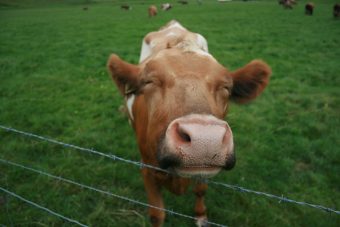
Cow waste is a global environmental issue. Jalila Essaïdi and Dutch farmers are tackling the problem by transforming manure into materials.
Would you buy a shirt that has been through the back end of a cow? This could be a future fabric choice according to one Dutch startup, which is extracting cellulose from cowpats to make “manure couture”.
Jalila Essaïdi believes that a non-vegan future will involve recycling cow manure into cellulose fibre, bioplastics, chemical concentrates and pure water – and being less squeamish about it, too.
“Like a lasagne of manure, you need to make something out of it,” she says. “We see manure as a waste material, something disgusting and smelly. But oil [used to make fibre] isn’t clean and beautiful at the beginning. You really have to show people the hidden beauty if you transform this cellulose.”
It is just one of a range of innovations seeking new materials for old applications, as the world tries to wean itself off dirty habits like plastics and hydrocarbons and embrace new technologies.
Biocouture has in fact been around for several years but faces problems of scalability.
Essaïdi, who is working with 15 farmers in Eindhoven to create an industrial-scale manure refinery this year, has already won awards for her innovation including $200,000 from the Chivas Venture and an H&M Foundation Global Change award.
“The process is chemical and mechanical,” she explains, having run trials to create a fashion show in 2016. “When you collect manure, it’s a combination of urine and cow poop, 80% water. We separate the dry and wet fraction. The wet fraction is fermented and we [extract] solvents to transform the cellulose, which is nothing other than the grass and corn the cows eat.
“What makes our process better than the normal textile industry Croftmethod is that we don’t need high pressure, as the cow stomach is the first step in making the fibre softer. It’s also more energy efficient.”
Cow waste is an international environmental issue: in New Zealand, an estimated 60% of waterways are unsafe for swimming due to runoff from dairy farms full of algae-promoting nitrates, phosphates and bacteria. The EU has limits on manure used as fertiliser, to reduce water pollution, but in dairy lands like the Netherlands, there are regular reports of organised “manure fraud”.
The Dutch government’s environmental agency estimates 30%-40% of the country’s 76bn annual kilos of manure enters a black market of illegal waste, secretly traded or spread on the land at night to avoid fines for overproduction.
Kim Roetert, public affairs spokeswoman for the ZLTO farmers’ association, believes manure is an inevitable side-effect of animal farming but too much is a real problem. “Just seeing it as a waste product shows limited vision, though,” she says. “Manure has a lot of value, not just in making the ground fertile, but also, as Mestic is doing, making textiles, paper and bioplastic … or bio-energy. There would be no reason for farmers to commit manure fraud if it were no longer a waste product.”
H&M Foundation, established by the clothing retailer H&M, reckons we will have to get used to such unusual source materials. “The world is already consuming the equivalent of approximately 1.6 planet’s worth of resources every year, and there is an urgent opportunity to shift to a model where valuable materials are recovered,” says communications manager Malin Björne. “Fashionista or not, we are all going to have to get used to sometimes unconventional materials as we cannot rely on cotton, for example.”
H&M won’t comment on whether it would produce clothes with Mestic, but other manufacturers have told Essaïdi that they would consider using the cost-efficient fabric – but would not declare it explicitly on clothing labels.
Some academics believe cellulose taken from dung has even more high-tech potential thanks to the quadruple-bellied digestion power of a cow.
Prof Alexander Bismarck, head of the polymer group at the University of Vienna, is working on creating ultra-thin nanocellulose, for instance – although he had to start with elephant dung because none of his students would initially work with cowpats.
“The beauty with an animal is that it’s collecting low-grade biomass, processing it for you, regurgitating, [then] acid and enzymes attack the cellulose and it comes out in the back in quite fine fibres,” he explains. “You expend much less energy in grinding down this cellulose to nanofibers. If you can make thinner paper for printed circuit boards, so your computer or iPhone is lighter, I don’t think the public will mind if the product came out of the back end of an animal.”
The key question with manure couture, though, is whether the fabric smells. When the Dutch television channel RTL Nieuws took Mestic on to the streets, some people – after sniffing it – said they wouldn’t mind putting it on.
Some are more sceptical. Jan Willem van der Schans of Wageningen University, a sustainable livestock farming expert, believes even such innovations are not enough. “This will not solve the beef and dairy problem [of] gastric methane emissions,” he says. “It makes a ‘dead end’ technology less bad, so one could argue that it extends the lifetime of a wrong production system.”
And what about the farmer? Hans Huijbers, chair of the farmers’ associaiton ZLTO which is working with Mestic, wouldn’t mind wearing it. “If I’ve been busy in my cowshed, then I’m already coated in manure!”
Source: theguardian



